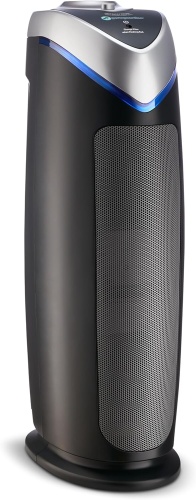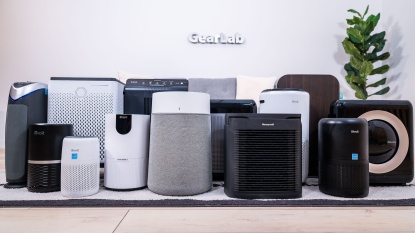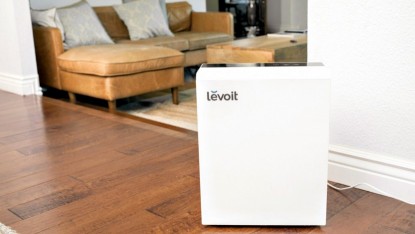GermGuardian AC4825E Review

Our Verdict
Our Analysis and Test Results
There isn't much that sets the GermGuardian AC4825E apart from its peers, except that it lacks things like smart integration, timers, or a nighttime mode. Some people might appreciate the simplicity of this device because it doesn't require much maintenance, and once it's unboxed, you simply have to plug it in, and it's ready to go.
Air Cleaning Performance
The CADR (Clean Air Delivery Rate) on the GermGuardian AC4825E is not the best, with ratings of 99 for smoke, 118 for dust, and 125 for pollen. These numbers are sizably lower than many of its peers—on paper, anyway. Despite this, it did well in our performance test. During the smoke test, it managed to remove 99.90% of harmful particles within the 60-minute timeframe. While the room cleared up considerably, the lingering smells were a bit of a letdown.
Noise
Sure, the GermGuardian can clean the air decently, but how does it sound? Unfortunately, it's pretty loud compared to most other purifiers. Using a decibel reader from about 6 feet away, we discovered that this model was relatively loud on the highest setting, registering 51.2 decibels, which is about as loud as a rain shower. The sound it produced was somewhat high-pitched and very noticeable. Testers noted that it had a “slightly whiny undertone”. On the medium setting, the result wasn't great either at 47 decibels. It did better on low at 41 decibels, but considering most air purifiers we've tested barely even register on the decibel reader on their lowest setting, this is still not ideal.
Ease of Use
Few devices are as easy to get running as the GermGuardian. The setup is as simple as unboxing it and plugging it in. When it's time to replace the filter, the indicator light will flash red to let you know. Changing out the filter is straightforward: the filter door on the back is easy to open, and the new filter clicks into place.
The interface is super simple, featuring only a dial to select the power level. A green indicator light beneath the dial illuminates when the machine is effectively switched on. Outside of that, there isn't much to mention. There is no smart integration via an app or quality-of-life features like a nighttime mode. In other words, it's relatively bare bones.
Operating Cost
The GermGuardian is not easy on the electricity bill. Using the national average kilowatt-hour rate, we determined just how efficient (or inefficient) it was. Assuming you'll be using it on the medium setting for around 12 hours a day, you'll be paying more to run this model compared to just about any other air purifier we've tested. Thankfully, the filters are very inexpensive, which helps make up for the lack of efficiency on the electricity front. When including the upfront cost of this device plus the electric and filter costs over the course of five years, we calculated the overall annual cost of this unit to be $105.
Should You Buy the GermGuardian AC4825E?
If you prioritize utter simplicity and straightforward operation, this model might be worth it. It's not incredibly expensive upfront and it does a pretty good job of keeping the air clean. If you don't want to fuss with additional features or smart integration, consider this model. However, in our opinion, your money is better spent on more robust air purifiers that are also more efficient across the board.
What Other Air Purifiers Should You Consider?
The Coway Airmega 200M is a more capable air purifier in nearly every sense, offering greater cleaning prowess and more features. It's also affordable, which is a significant consideration. Additionally, the Coway Airmega 1512HH outclasses it in every aspect but has a slightly higher operating cost, although not by much.









